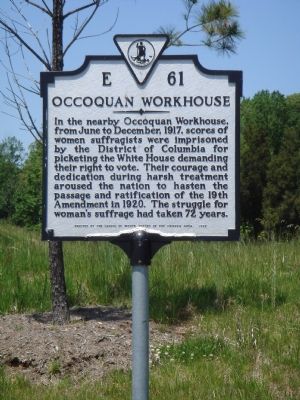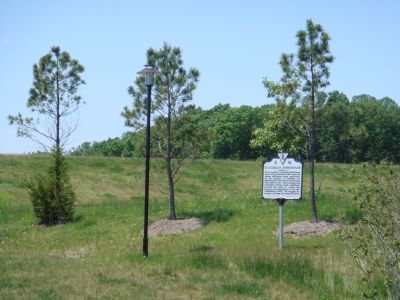Near Lorton in Fairfax County, Virginia — The American South (Mid-Atlantic)
Occoquan Workhouse
Erected 1982 by the League of Women Voters of the Fairfax Area; Virginia Department of Historic Resources. (Marker Number E-61.)
Topics and series. This historical marker is listed in this topic list: Civil Rights. In addition, it is included in the Virginia Department of Historic Resources (DHR) series list. A significant historical month for this entry is December 1917.
Location. 38° 41.839′ N, 77° 15.365′ W. Marker is near Lorton, Virginia, in Fairfax County. Marker is at the intersection of Ox Road (Virginia Route 123) and Workhouse Way, on the right when traveling north on Ox Road. Touch for map. Marker is in this post office area: Lorton VA 22079, United States of America. Touch for directions.
Other nearby markers. At least 8 other markers are within walking distance of this marker. Irma Clifton (within shouting distance of this marker); Prisoners at the Workhouse (about 300 feet away, measured in a direct line); Development of a Progressive-Era Model Penal System (about 400 feet away); a different marker also named Occoquan Workhouse (about 600 feet away); Lorton Nike Missile Site (approx. 0.7 miles away); Occoquan River Bridges (approx. 0.9 miles away); Historic Occoquan (approx. 0.9 miles away); Town of Occoquan (approx. 0.9 miles away). Touch for a list and map of all markers in Lorton.
More about this marker. The marker was originally erected on Rt 123 at the entrance to the Occoquan Regional Park. The Lorton Prison complex was immediately north of the marker on both sides of the road. It was removed when work began on realigning and widening of Rt 123 and eventually re-erected at the Water Works north of where the prison stood. The marker was once again relocated 0.2 miles south of its previous location at the intersection of Ox Rd & Workhouse Rd (38.69967N, 77.25659W). It is said that when originally erected in 1982, this was the first marker in the state to recognize civil rights and women’s rights.
Regarding Occoquan Workhouse. The Occoquan Workhouse, and later the Lorton Reformatory, was a District of Columbia operated prison
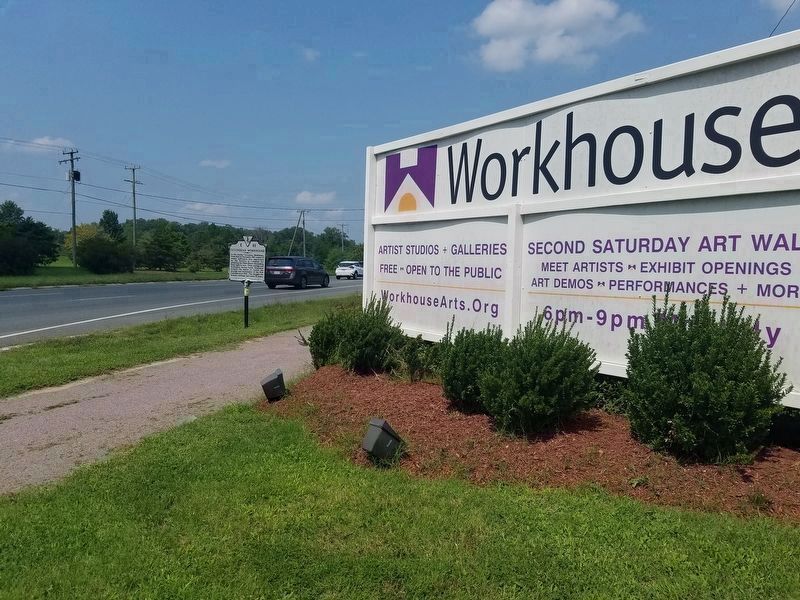
Photographed By Judith Elizabeth Pearson, August 26, 2021
2. Occoquan Workhouse Marker (relocated)
The Occoquan Workhouse Marker is now on Ox Road, Virginia Route 123 northbound, in Lorton Virginia. It is next to the entrance for the Workhouse Arts Center that occupies the grounds and buildings of what was once the Occoquan Workhouse, later Occoquan Reformatory. An educational marker on the grounds states that the building where the suffragettes were imprisoned and tortured no longer stands.
Related marker. Click here for another marker that is related to this marker.
Also see . . .
1. History of the Lorton Prison Complex. (Submitted on May 19, 2007.)
2. Turning Point Suffragist Memorial c. (Submitted on August 27, 2021.)
Additional keywords. 19th Ammendment to the Constitution
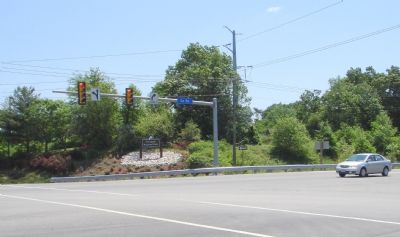
Photographed By J. J. Prats, May 19, 2007
4. Original Location of Marker
The marker was originally erected in 1982 on Route 123 at the entrance to the Occoquan Regional Park. The Lorton Prison complex was immediately north of the marker on both sides of the road. It was removed when work began on realigning and widening of Route 123 and eventually re-erected at the Water Works north of where the prison stood.
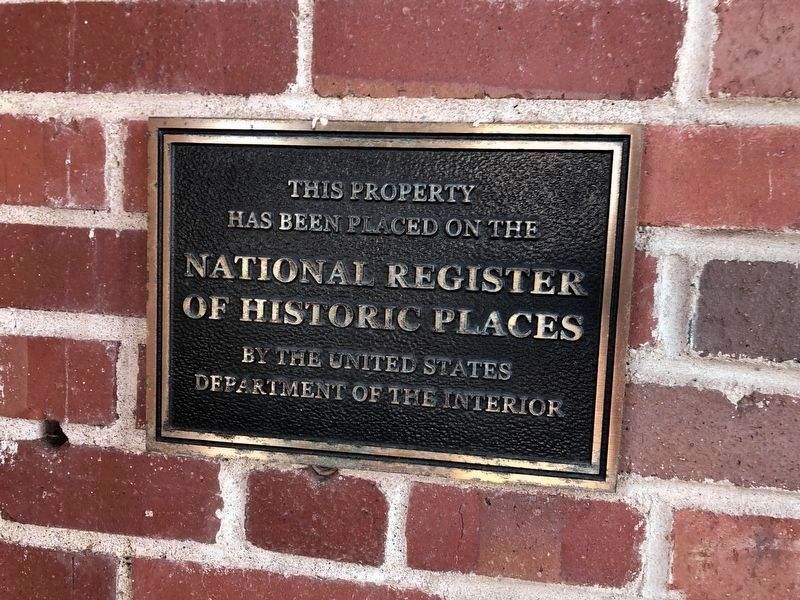
Photographed By Devry Becker Jones (CC0), February 2, 2020
5. Plaque on the building in the complex
has been placed on the
National Register
of Historic Places
by the United States
Department of the Interior
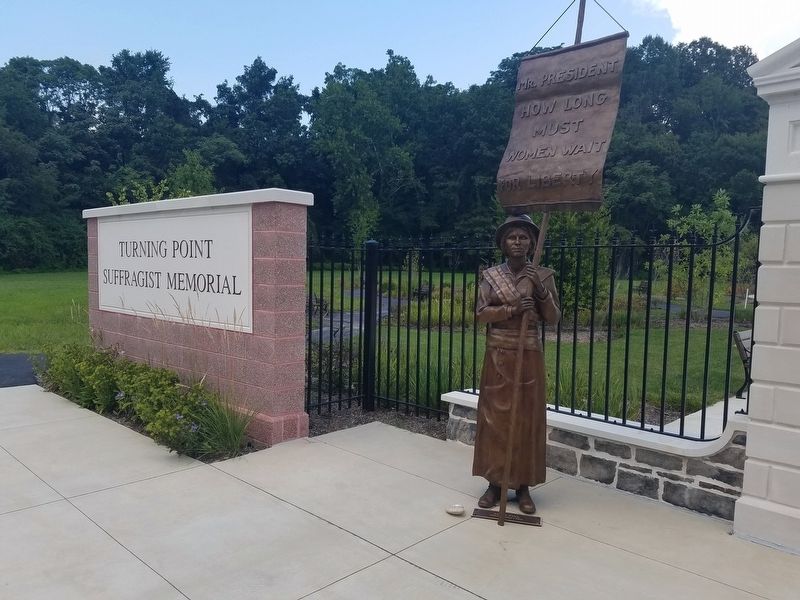
Photographed By Judith Elizabeth Pearson, August 26, 2021
6. Entrance to Turning Point Suffragist Memorial
The Occoquan Workhouse marker states that suffragists were imprisoned at this location in 1917, because of their efforts for the right to vote. In May 2021 the Turning Point Suffragist Memorial was dedicated to honor these women. The memorial is about three miles away from the marker, at the end of the road going into Occoquan Regional Park. The park entrance intersects with Ox Road 123 North, south of the marker. The memorial recounts the history of the suffragist movement of the early 20th century.
Credits. This page was last revised on August 27, 2021. It was originally submitted on May 19, 2007, by J. J. Prats of Powell, Ohio. This page has been viewed 6,934 times since then and 36 times this year. Last updated on March 5, 2021, by Nancy B. Kennedy of Hopewell, New Jersey. Photos: 1. submitted on May 19, 2007, by J. J. Prats of Powell, Ohio. 2. submitted on August 26, 2021, by Judith Elizabeth Pearson of Burke, Virginia. 3, 4. submitted on May 19, 2007, by J. J. Prats of Powell, Ohio. 5. submitted on February 2, 2020, by Devry Becker Jones of Washington, District of Columbia. 6. submitted on August 26, 2021, by Judith Elizabeth Pearson of Burke, Virginia. • Bernard Fisher was the editor who published this page.
